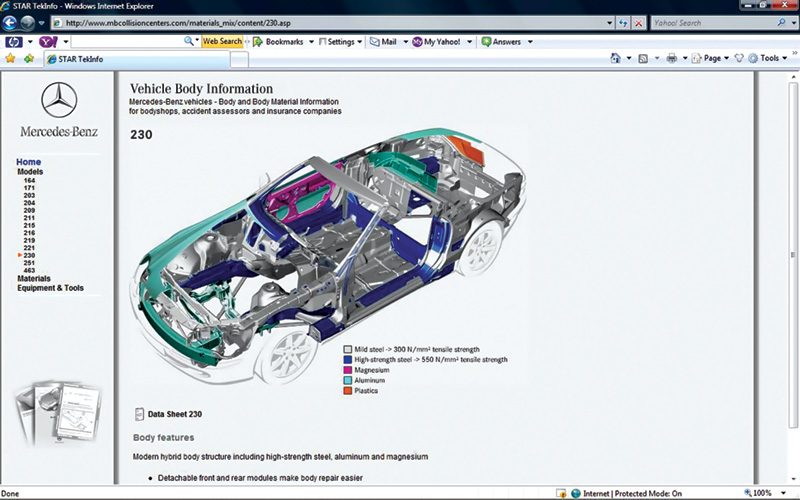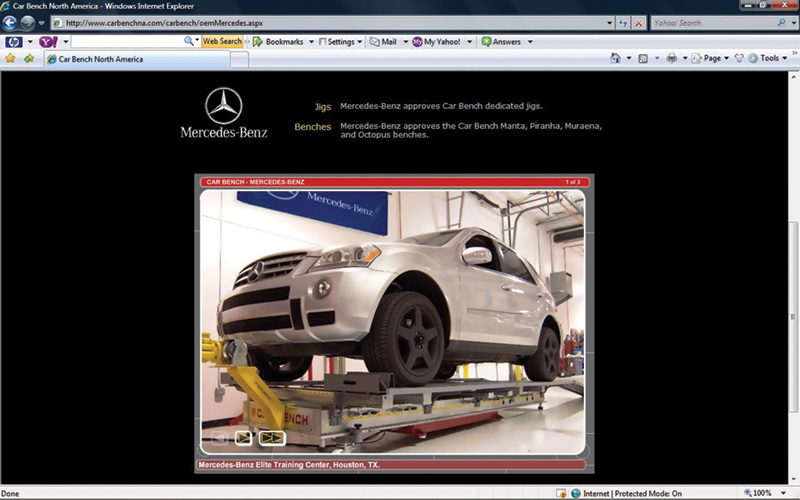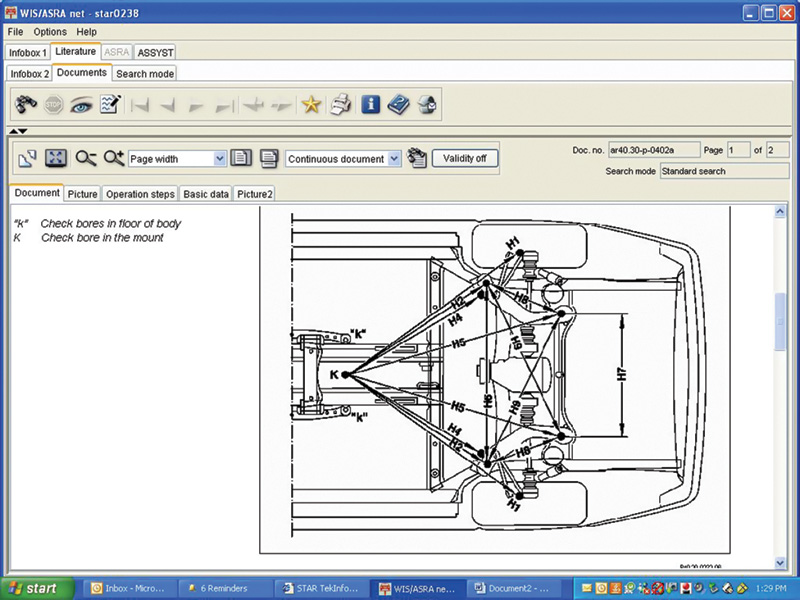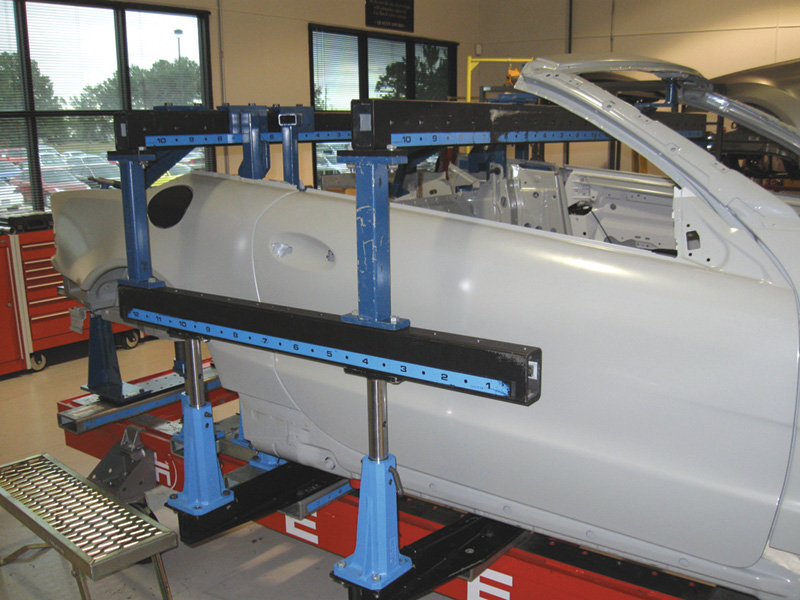When evaluating chassis integrity after collision damage you need to take the extra steps to verify straightness. The inherent value of a Mercedes-Benz vehicle definitely makes these extra steps worthwhile.
Look at the collision industry statistics compiled in the last few years and you will notice an increase in vehicles defined as a total loss by insurance companies. The reason for this is multi-faceted. Increases in the cost of parts, the shortage of certified body techs, and collision repair facility tooling/environmental compliance costs have all contributed to the overall price of a repair. Also, the vehicles themselves often contribute to the added cost. Exotic metals, construction welding technology and fastening techniques have all required retooling and training, which adds to the overhead of any collision repair shop. Mercedes-Benz vehicles, however, retain sufficient value to justify the cost of repairing most collision damage.
Reputable shops know the importance of returning the vehicle’s structural integrity to its pre-collision state. When dealing with frame damage, it’s essential to restore the basic framework for proper chassis dynamics (such as suspension alignment) and future crash-worthiness. You may ask yourself, “When should I check chassis alignment?†and, “How can I do a better job of pulling that chassis into alignment?â€
Assessment
One of the first steps that is often overlooked and/or taken for granted is the damage assessment. This is more than just a visual overview of the parts that will need to be replaced. A deeper analysis should be incorporated into the assessment. Look at the point of impact and determine its direction. You should think like a detective at this point and try to recreate the accident in your head. It sounds like common sense, but this usually gives a good indication of what points you should start pulling from. Also, this may be a good way to gauge from what direction you should start pulling once the chassis has been initially straightened.
Next, look for damage at the farthest point from the impact. This gives you the total surface area of all of the damaged panels. Even if the damage in this area is minimal, it needs to be straightened. During the pulling process, it can be used as a gauge of the straightness of the overall section. If the farthest point of damage after pulling has now returned to its original shape, you may want to start pulling from another point.

Before you start the pulling process you need to know what metals you are working with. Mercedes-Benz uses different metals with different strength levels to achieve structural strength and occupant safety. A visit to www.mbcollisioncenters.com and your membership gets you this important data.
Back to assessing the damage, the next step is to look for indirect or secondary damage that was caused by this collision. Although we realize this is not always the case, it is often a good idea to start pulling the frame in a linear direction extending the body front to rear. Pulling front to rear will “stretch†the chassis into a straighter position. Obviously, with corners and angled frame panels this will not always be the best way to go, but it is a start. Sometimes it is better to pull the framework at 90 degree angles to the panel’s original location. This may take several steps as you change the location and/or the direction of the pull point to stay perpendicular to the panel you are pulling. These are just some general guidelines regarding frame alignment meant to get you thinking about the next step, which is developing a repair plan.

Car Bench is a Mercedes-Benz approved alignment jig for frame straightening. There are various models available, and by visiting www.carbenchna.com you can arrange bench rental and download measurement specifications.
Measuring Up
An old adage says, “Before you can go anywhere you have to know where you are.†The same can be said for frame straightening. This next step in the repair process involves measuring chassis alignment on a bench or “jig†against Mercedes-Benz or the bench manufacturer’s specifications. Here is where a hard decision has to be made: Is the frame damaged beyond repair? No one wants to put in all the labor to get to this point and not repair the vehicle. Totals should have been weeded out during the damage estimate.
On earlier Mercedes-Benz models (previous to the 210 chassis), chassis damage was measured off of a K-point. That is, a point within the driveshaft tunnel that was hopefully the least likely to be hit in an accident. The K-point is a diagnostic tool for body men to use to straighten frames. From this K-point you measure the distance to all suspension pick-up points and see if the chassis has twisted. From here, you pull on the frame until you match the measurements. These measurements are supplied by Mercedes-Benz through WIS-Net, which you can access with a paid subscription to www.startekinfo.com. Aside from having the step-by-step procedure to replace interior body panels, it also contains measurements for K-point frame diagnostic procedures. If you have a hard time locating the K-point measurement specifications, try entering a chassis number or the entire VIN and look under group 40.30.

With a paid subscription to www.startekinfo.com, you can use WIS-Net to pull up the K-point measurement data. This information is only used for diagnostic purposes, particularly on older models built before the turn of the millennium. You can use these measurement points to see how bad the damage is.
Newer vehicles utilize a different procedure: measuring off of an alignment bench. Mercedes-Benz has approved two bench manufacturers for chassis alignment, the Car Bench, and the Celette chassis alignment bench. If you have invested in the Celette or Car Bench jig, you can access those measurements from their websites. The Celette website is www.celette-us.com. On the home page, select the “Fixture bench Setup Sheets†field, then select your model chassis. There may be VIN number differences, so be sure to select the correct identification number. The Car Bench website is www.carbenchna.com. From the home page, select “Support,†then “Resources.†From there, select the “+†symbol next to the heading “Datasheets,†followed by the type of bench you are working with, the manufacturer (Mercedes-Benz), model and chassis variant if applicable. Rental units are available from either manufacturer. These are the two chassis alignment jigs officially approved by Mercedes-Benz.

Here is a Celette bench with a 230 chassis set up for measurements and pulling. The framework setup and procedures are all available on the website. Remember, you can use higher strength steels to pull lower strength steel, but you cannot reverse the rule.
Bending To Your Will

Here is a frame attached to the bench. Points on the chassis can be measured from here, and you can start the pulling process. On this 230 chassis, you need to be aware of the different metals and their relative strengths.
Once the chassis is on the bench and the measurements have been taken, you can start pulling. Frame straightening is an art developed through experience, but there are some relatively new concerns with Mercedes-Benz designs and metal composition. In some cases, of course, the damage to a panel will be so great that straightening may not be the best option compared to replacement. In the case of high-strength steel, this becomes a requirement. High-boron steel is very difficult to reform after crash damage because it is so strong. Mercedes-Benz uses four grades of steel: mild steel, high-strength steel, modern high-strength steel and finally ultra high-strength steel. Mild steel is much easier to pull. The higher strength steels can be pulled, but often return to the pre-pulled shape. Ultra high-strength steel is heat formed, so without extensive equipment it is virtually impossible to reform and will need to be replaced. When damage is localized, it is much easier to cut out the damaged section and replace it.

With your paid subscription to www.startekinfo.com, you can access step-by-step instructions for alignment bench assembly and measurement procedures. You also are provided with replacement procedures for interior structural panels as well
as exterior body panels.
Ultra-high strength steel is more widely used in new Mercedes-Benz chassis such as the 204, 216 and 251, and to a lesser degree on the 164, 171, 211, 215 and 220 chassis. The 216 chassis has incorporated even more higher-strength steels than other Mercedes-Benz models. When pulling ultra high-strength steel, it will obviously react differently from modern high-strength, high-strength and mild steel. The key point to remember is that you can use higher-strength steels to pull and align lower-strength steels, but you cannot do the opposite for obvious reasons. You will simply deform the lower-strength steels in the process. Use ultra high-strength to pull the chassis, then cut out the sections of ultra high-strength steel and weld or bond and rivet in the new sections. In the case of the 215 chassis, you have to be even more careful pulling panels since high-strength steel and mild steel is mated with aluminum structural panels. On a positive note, when pulling aluminum Mercedes-Benz always recommends replacement over repair work.
In Conclusion
Your extensive experience as a body man will serve you well while assessing the damage, measuring the alignment points and during the actual pulling procedure. Simply keep in mind the Mercedes-Benz recommended procedures outlined in WIS-Net and the knowledge of the various metal compositions of the chassis you are working on should yield a structurally-sound and trouble free-repair.






0 Comments